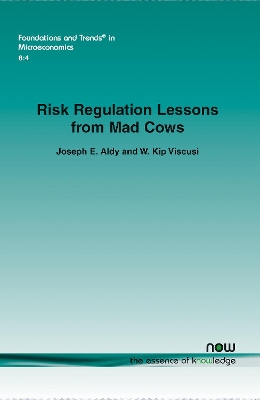Foundations and Trends (R) in Microeconomics
2 total works
Risk Regulation Lessons from Mad Cows
by Joseph E. Aldy and W. Kip Viscusi
Published 30 December 2013
Risk Regulation Lesson from Mad Cows analyses and compares the policy responses in the United Kingdom (U.K.) and the United States (U.S.) to the mad cow disease crisis. Although there was not nearly as many deaths related to Creutzfeldt-Jakob disease (vCJD) and bovine spongiform encephalopathy (BSE) as scientist had predicted, the U.K. mad cow experience is widely regarded as a major policy debacle. The authors review the policy failures in the U.K., and also explain why the absence of comparable crisis in the U.S. does not signal that the mad cow experience has been a U.S. policy success story. This monograph draws a number of lessons from the mad cow experience regarding how one should regulate invasive species risks and deal with dimly understood but potentially serious risks to large populations.
Risk Regulations Lesson from Mad Cows is organized as follows. After a brief Introduction, Section 2 examines the nature of risks to animals and humans from BSE and vCJD. Section 3 presents a mainstream public policy framework to evaluate the welfare consequences of BSE and vCJD risk mitigation instruments. Section 4 examines how other governments have conceptualized the risks for policy purposes. After providing a chronology of the policy events and policy actions in Section 5, the authors examine issues pertaining to media coverage and risk communication in Section 6. Consumer responses to the informational environment are reviewed in Section 7, and governments' use of trade policy in Section 8. A controversial effort by one beef producer to have its beef certified as being BSE-free brings together a wide set of cross-cutting issues of risk communication, government regulation, litigation, and international trade, and will serve as the main policy case study in Section 9. Lastly, in Section 10 the authors conclude with a review of general lessons for regulatory policy learned from the crisis.
Risk Regulations Lesson from Mad Cows is organized as follows. After a brief Introduction, Section 2 examines the nature of risks to animals and humans from BSE and vCJD. Section 3 presents a mainstream public policy framework to evaluate the welfare consequences of BSE and vCJD risk mitigation instruments. Section 4 examines how other governments have conceptualized the risks for policy purposes. After providing a chronology of the policy events and policy actions in Section 5, the authors examine issues pertaining to media coverage and risk communication in Section 6. Consumer responses to the informational environment are reviewed in Section 7, and governments' use of trade policy in Section 8. A controversial effort by one beef producer to have its beef certified as being BSE-free brings together a wide set of cross-cutting issues of risk communication, government regulation, litigation, and international trade, and will serve as the main policy case study in Section 9. Lastly, in Section 10 the authors conclude with a review of general lessons for regulatory policy learned from the crisis.
Policy Challenges of the Heterogeneity of the Value of Statistical Life
by W. Kip Viscusi
Published 30 July 2011
Focuses on the variation in VSL both across different studies in the academic literature and in different policy contexts. These differences often reflect quite legitimate heterogeneity in the valuation of risk. This review of the academic literature is coupled with an examination of the policy arena's use of the VSL methodology.
Government agencies adopted the VSL approach to valuing risk regulations almost three decades ago. As government agencies continue to refine their benefit assessment procedure, the potential role of heterogeneity of VSL has moved to the forefront of these debates. Sections II through IV review various analytical underpinnings of the VSL methodology, particularly focusing onlabour market estimates. Subsequent sections consider different sources of heterogeneity, how these sources should influence benefit assessments, and how they have been used in actual policy contexts.
Government agencies adopted the VSL approach to valuing risk regulations almost three decades ago. As government agencies continue to refine their benefit assessment procedure, the potential role of heterogeneity of VSL has moved to the forefront of these debates. Sections II through IV review various analytical underpinnings of the VSL methodology, particularly focusing onlabour market estimates. Subsequent sections consider different sources of heterogeneity, how these sources should influence benefit assessments, and how they have been used in actual policy contexts.

